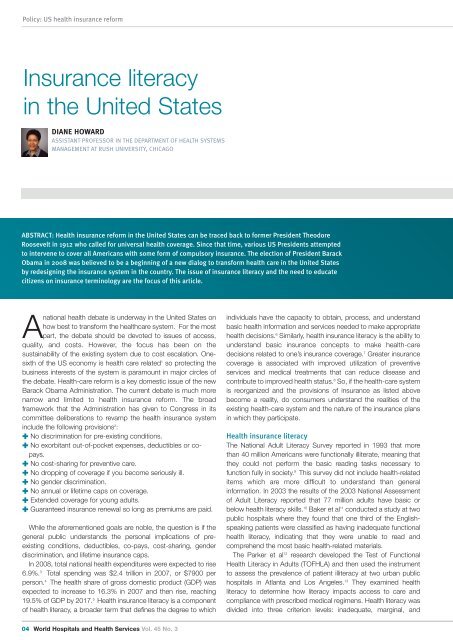vol45.3 LR.pdf - International Hospital Federation
vol45.3 LR.pdf - International Hospital Federation
vol45.3 LR.pdf - International Hospital Federation
You also want an ePaper? Increase the reach of your titles
YUMPU automatically turns print PDFs into web optimized ePapers that Google loves.
Policy: US health insurance reform<br />
Insurance literacy<br />
in the United States<br />
DIANE HOWARD<br />
ASSISTANT PROFESSOR IN THE DEPARTMENT OF HEALTH SYSTEMS<br />
MANAGEMENT AT RUSH UNIVERSITY, CHICAGO<br />
ABSTRACT: Health insurance reform in the United States can be traced back to former President Theodore<br />
Roosevelt in 1912 who called for universal health coverage. Since that time, various US Presidents attempted<br />
to intervene to cover all Americans with some form of compulsory insurance. The election of President Barack<br />
Obama in 2008 was believed to be a beginning of a new dialog to transform health care in the United States<br />
by redesigning the insurance system in the country. The issue of insurance literacy and the need to educate<br />
citizens on insurance terminology are the focus of this article.<br />
Anational health debate is underway in the United States on<br />
how best to transform the healthcare system. For the most<br />
part, the debate should be devoted to issues of access,<br />
quality, and costs. However, the focus has been on the<br />
sustainability of the existing system due to cost escalation. Onesixth<br />
of the US economy is health care related 1 so protecting the<br />
business interests of the system is paramount in major circles of<br />
the debate. Health-care reform is a key domestic issue of the new<br />
Barack Obama Administration. The current debate is much more<br />
narrow and limited to health insurance reform. The broad<br />
framework that the Administration has given to Congress in its<br />
committee deliberations to revamp the health insurance system<br />
include the following provisions 2 :<br />
✚ No discrimination for pre-existing conditions.<br />
✚ No exorbitant out-of-pocket expenses, deductibles or copays.<br />
✚ No cost-sharing for preventive care.<br />
✚ No dropping of coverage if you become seriously ill.<br />
✚ No gender discrimination.<br />
✚ No annual or lifetime caps on coverage.<br />
✚ Extended coverage for young adults.<br />
✚ Guaranteed insurance renewal so long as premiums are paid.<br />
While the aforementioned goals are noble, the question is if the<br />
general public understands the personal implications of preexisting<br />
conditions, deductibles, co-pays, cost-sharing, gender<br />
discrimination, and lifetime insurance caps.<br />
In 2008, total national health expenditures were expected to rise<br />
6.9%. 3 Total spending was $2.4 trillion in 2007, or $7900 per<br />
person. 4 The health share of gross domestic product (GDP) was<br />
expected to increase to 16.3% in 2007 and then rise, reaching<br />
19.5% of GDP by 2017. 5 Health insurance literacy is a component<br />
of health literacy, a broader term that defines the degree to which<br />
individuals have the capacity to obtain, process, and understand<br />
basic health information and services needed to make appropriate<br />
health decisions. 6 Similarly, health insurance literacy is the ability to<br />
understand basic insurance concepts to make health-care<br />
decisions related to one’s insurance coverage. 7 Greater insurance<br />
coverage is associated with improved utilization of preventive<br />
services and medical treatments that can reduce disease and<br />
contribute to improved health status. 8 So, if the health-care system<br />
is reorganized and the provisions of insurance as listed above<br />
become a reality, do consumers understand the realities of the<br />
existing health-care system and the nature of the insurance plans<br />
in which they participate.<br />
Health insurance literacy<br />
The National Adult Literacy Survey reported in 1993 that more<br />
than 40 million Americans were functionally illiterate, meaning that<br />
they could not perform the basic reading tasks necessary to<br />
function fully in society. 9 This survey did not include health-related<br />
items which are more difficult to understand than general<br />
information. In 2003 the results of the 2003 National Assessment<br />
of Adult Literacy reported that 77 million adults have basic or<br />
below health literacy skills. 10 Baker et al 11 conducted a study at two<br />
public hospitals where they found that one third of the Englishspeaking<br />
patients were classified as having inadequate functional<br />
health literacy, indicating that they were unable to read and<br />
comprehend the most basic health-related materials.<br />
The Parker et al 12 research developed the Test of Functional<br />
Health Literacy in Adults (TOFHLA) and then used the instrument<br />
to assess the prevalence of patient illiteracy at two urban public<br />
hospitals in Atlanta and Los Angeles. 13 They examined health<br />
literacy to determine how literacy impacts access to care and<br />
compliance with prescribed medical regimens. Health literacy was<br />
divided into three criterion levels: inadequate, marginal, and<br />
04 World <strong>Hospital</strong>s and Health Services Vol. 45 No. 3

















